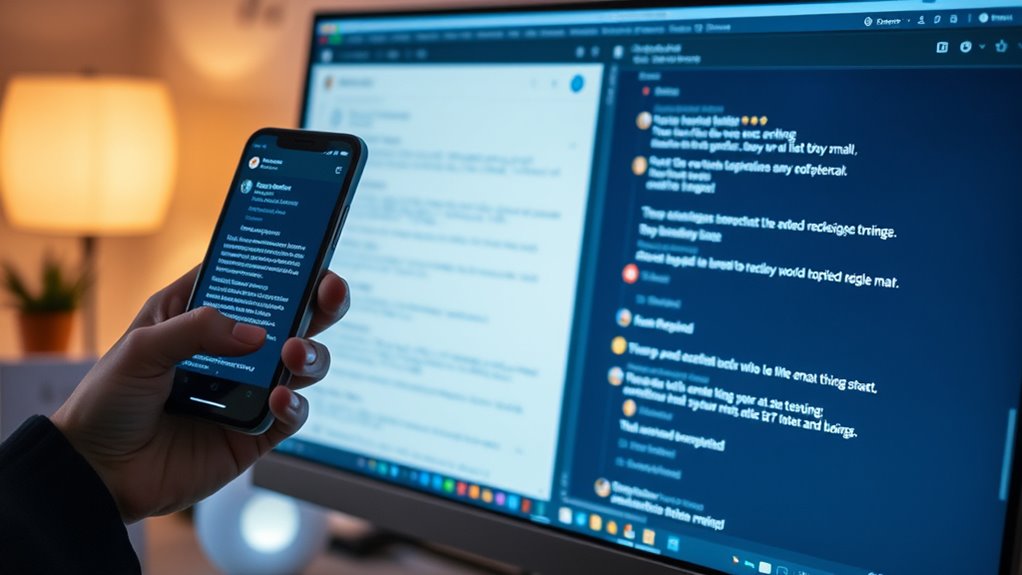In remote work, understanding digital body language helps you interpret cues like message tone, response timing, and engagement during virtual meetings. Watch for email delays or emoji use that reveal emotions, and notice facial expressions, posture, or eye contact during video calls to gauge interest or discomfort. Recognizing these signals allows you to respond empathetically and build better connections. Keep exploring these clues to enhance your remote communication skills further.
Key Takeaways
- Digital body language includes cues like response times, facial expressions, and emoji reactions that reveal engagement and emotional states.
- Monitoring eye contact, posture, and gestures during video calls helps assess participant attentiveness and comfort levels.
- Response delays and participation patterns indicate distraction, interest, or workload, aiding effective communication.
- Virtual backgrounds and visual environment cues influence perceptions of professionalism and attentiveness in remote settings.
- Recognizing tone, punctuation, and response timing in text communication enhances understanding of intent and emotional nuance.
Recognizing Email and Message Cues

When it comes to digital communication, recognizing email and message cues is essential for understanding the sender’s intent. Virtual eye contact isn’t literal here, but you can gauge engagement through tone and timing. If someone takes time before replying, they might be considering their response carefully, indicating importance. Emoji usage also plays a key role; a smiley can soften a message or show friendliness, while a serious emoji might signal urgency or concern. Pay attention to punctuation and formatting—excessive exclamation points could suggest enthusiasm, whereas brief, curt replies might indicate impatience. By observing these cues, you can better interpret whether a message is friendly, professional, or urgent, helping you respond appropriately and build clearer communication in remote settings. Additionally, understanding the power consumption of communication tools can help manage your digital environment more effectively.
Interpreting Virtual Meeting Behaviors

During virtual meetings, you can gauge engagement by watching participants’ facial expressions and responses. Noticing nonverbal cues like nodding or leaning in helps you understand who is actively involved. Managing distractions, like side conversations or multitasking, guarantees you interpret behaviors accurately and keep the discussion focused. Additionally, observing if participants are using acne patches or other skincare products can reveal their comfort level and confidence during interactions.
Recognizing Engagement Levels
Recognizing engagement levels in virtual meetings requires paying close attention to participants’ behaviors and cues. You can gauge involvement through digital eye contact—are they looking at the screen or distracted? Notice their responses to your questions; quick replies suggest interest, while delayed or minimal responses might indicate disengagement. Emoji interpretation also helps; frequent positive emojis show enthusiasm, whereas neutral or absent reactions may signal boredom. The use of high-quality projectors can further enhance visual communication, making cues easier to interpret.
Noticing Nonverbal Cues
Paying attention to nonverbal cues in virtual meetings can reveal much about participants’ true feelings and engagement levels. By developing body language awareness, you can better interpret digital nonverbal cues that signal interest, confusion, or disengagement. Look for these signs:
- Frequent eye contact or looking away
- Facial expressions like frowning or smiling
- Posture shifts, leaning forward or slouching
- Hand gestures or fidgeting
- Response timing, such as delayed replies
These cues, though subtle, provide insight into how participants really feel beyond their words. Recognizing and interpreting digital nonverbal cues helps you gauge engagement more accurately and adapt your communication style accordingly. Paying close attention to these cues can foster clearer, more meaningful interactions in virtual environments. Enhancing relevance and authority through understanding body language in digital settings can significantly improve overall communication effectiveness.
Managing Virtual Distractions
Managing virtual distractions requires you to interpret participants’ behaviors effectively, as they often signal when their attention lapses or shifts. Recognizing cues like frequent scrolling, checking phones, or drifting eyes helps you address distractions early. Encourage a digital detox by suggesting breaks or turning off notifications during meetings. Workspace personalization also plays a role; a cluttered or overly casual setup might lead to decreased focus. Use this table to identify common virtual behaviors and their meanings:
| Behavior | Possible Interpretation |
|---|---|
| Looking away frequently | Disinterest or multitasking |
| Multitasking (e.g., typing) | Distraction or unrelated work |
| Fidgeting or shifting seat | Restlessness, boredom |
| Checking phone or apps | Lack of engagement |
| Background noise or movement | Environmental distraction |
Being aware of personality traits such as passive-aggressive behaviors or manipulative tendencies can also help you better interpret underlying reasons for distraction or disengagement during virtual meetings.
Analyzing Response Times and Availability

Analyzing response times and availability offers valuable insights into how others communicate and how receptive they are to engagement. Digital cues, like quick replies or delayed responses, reveal a person’s communication style and current availability signals. Recognizing these cues helps you gauge whether someone is open to conversation or busy. Consistent observation of these patterns can also foster a greater awareness of attention management, enhancing your ability to interpret subtle signals accurately.
Spotting Engagement Through Digital Interactions

You can spot engagement by paying attention to response time indicators and participation patterns. Quick replies often show interest, while consistent activity reveals ongoing involvement. Recognizing these digital signals helps you understand how engaged someone truly is. Additionally, observing natural enzymes in vegetables that promote healthy interactions can further clarify their level of engagement.
Response Time Indicators
Response time is a powerful indicator of engagement in digital interactions. When colleagues reply promptly, it often shows interest and attentiveness. Quick responses can reflect enthusiasm, while delays may suggest distraction or disinterest. Pay attention to how response times align with digital gestures and online etiquette; consistent delays might signal disengagement or overwhelm. Conversely, timely replies foster trust and collaboration. Factors influencing response time include workload, communication style, and personal habits. Here are some key points to watch for:
- Consistently swift replies indicating active engagement
- Extended delays hinting at distraction or conflicting priorities
- Patterns of response timing during different times of day
- Use of emojis or quick acknowledgments to show attentiveness
- Response lag during busy periods or outside work hours
- Detect passive voice in messages to ensure clarity and directness
Understanding these cues helps you gauge genuine interest and maintain effective remote communication.
Participation Patterns
Participation patterns in digital interactions offer valuable insights into someone’s level of engagement. You can interpret cues like gesture recognition and eye contact to gauge involvement. Consistent camera use and lively gestures suggest active participation, while minimal movement or disengagement signals the opposite. Consider this table:
| Engagement Indicator | Meaning |
|---|---|
| Frequent gestures | High engagement |
| Sustained eye contact | Focused and attentive |
| Lack of movement | Possible disengagement |
Additionally, incorporating aesthetic home decor elements into virtual backgrounds can subtly influence perceptions of professionalism and attentiveness.
Understanding Tone and Context in Text Communication

Understanding tone and context in text communication is essential because written messages often lack the vocal cues and body language that convey meaning in face-to-face interactions. Without these cues, messages can be misunderstood or misinterpreted. To improve clarity, focus on developing digital empathy and tone calibration. Pay attention to subtle cues like word choice, punctuation, and response timing. Consider the recipient’s perspective and avoid assumptions. Use clarity and brevity to prevent confusion. Be mindful of cultural differences and emotional states that influence interpretation. Remember, tone isn’t just in words; it’s shaped by your intent and how others perceive it. Recognizing the importance of crochet styles for locs can also help in understanding different ways people express themselves visually and stylistically. Reflect on how your message might be received. Practice empathy to foster understanding.
Observing Non-Verbal Signals in Video Calls

When you’re in a video call, paying attention to non-verbal signals can reveal a lot about how others are truly feeling and reacting. Notice their virtual eye contact—are they looking directly at the camera or distracted elsewhere? This indicates engagement or disinterest. Watch their facial expressions and posture, which can show enthusiasm, confusion, or boredom. Emoji interpretation also plays a role; participants may use reactions or icons to express emotions without speaking. For example, a thumbs-up might signal agreement, while a sad face indicates concern. Combining these cues helps you gauge sincerity and comfort levels, even when words are limited. Being attentive to these digital body language signals enhances your understanding of the remote environment and fosters more effective communication.
Building Empathy Through Digital Body Language

Noticing non-verbal signals in video calls helps you connect more deeply with others, fostering empathy even through a screen. By paying attention to digital body language, you build virtual rapport and strengthen digital trust. When colleagues show engagement through nodding, leaning in, or maintaining eye contact, you sense their genuine interest. Conversely, crossed arms or distracted looks may signal discomfort or disengagement, prompting you to adjust your approach. To nurture empathy:
- Observe facial expressions for emotional cues
- Note tone and pacing of speech
- Recognize gestures that indicate openness
- Pay attention to eye contact and blinking
- Be mindful of background distractions
These subtle signals deepen understanding, making remote interactions more authentic and empathetic. Building this awareness enhances relationships and cultivates a more collaborative virtual environment.
Frequently Asked Questions
How Can I Distinguish Genuine Disinterest From Busy Schedules Online?
To distinguish genuine disinterest from busy schedules online, pay attention to email engagement and response promptness. If someone regularly responds quickly and thoughtfully, they’re likely interested. However, if responses are delayed or minimal despite clear engagement, they might be busy or disinterested. You can also look for follow-up questions or continued conversation, which indicate genuine interest. Remember, consistent patterns reveal more than isolated, sporadic responses.
What Digital Cues Indicate Burnout or Emotional Fatigue Remotely?
When noticing signs of burnout or emotional fatigue remotely, pay attention to digital cues like reduced responsiveness, delayed replies, or a sudden drop in engagement. You might see virtual fatigue reflected in decreased enthusiasm or frequent multitasking during meetings. Emotional exhaustion can show through curt messages or a lack of initiative. By observing these cues, you can offer support and help address underlying stress before it worsens.
How Do Cultural Differences Affect Digital Body Language Interpretation?
Imagine trying to decode a secret message in a language you barely understand—that’s what interpreting digital body language across cultures feels like. Cultural nuances and communication styles can turn a simple emoji or reply into a complex puzzle. You might miss subtle cues or misread intentions, causing misunderstandings. To bridge this gap, you need awareness of these cultural differences, adapt your communication, and stay open-minded to truly connect across borders.
Can Digital Body Language Predict Future Team Collaboration Success?
You wonder if digital body language can predict future team collaboration success. By observing virtual rapport and emoji cues, you can gauge openness and engagement, which are key indicators. When team members share positive virtual rapport and frequently use encouraging emoji cues, it suggests strong potential for successful collaboration ahead. Recognizing these digital cues helps you foster better teamwork and build trust, improving overall project outcomes.
What Tools Best Support Reading Cues Beyond Standard Communication Platforms?
You’re seeking tools that go beyond standard communication platforms to better read cues. Virtual gesture recognition captures subtle physical signals, while emotional analytics tools analyze tone and expressions for deeper insights. These technologies supplement traditional messaging, helping you understand team members’ feelings and engagement levels more accurately. By integrating these tools, you can foster clearer communication, build stronger remote relationships, and ensure your team stays connected and productive in a virtual environment.
Conclusion
By mastering digital body language, you can better understand your remote colleagues. For example, noticing a colleague’s quick responses might indicate engagement, while delayed replies could signal overwhelm. When you pay attention to these cues—like tone in messages or eye contact in video calls—you build stronger connections and foster empathy. Ultimately, reading digital cues helps you navigate remote work more effectively, creating a collaborative environment where everyone feels understood and valued.









